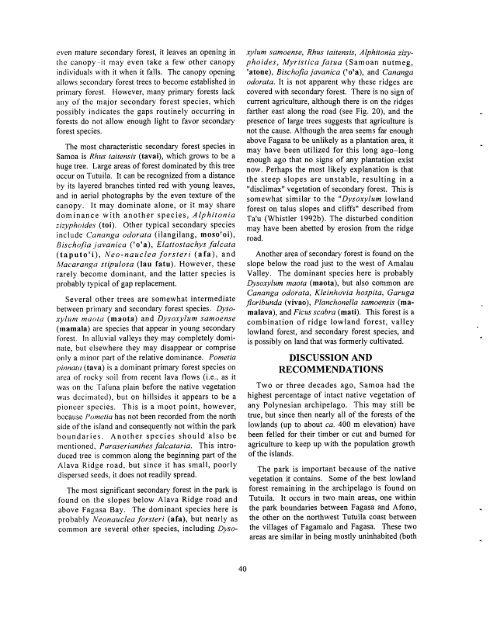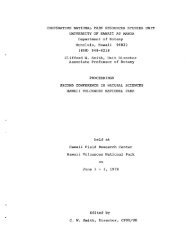american samoa - University of Hawaii at Manoa
american samoa - University of Hawaii at Manoa
american samoa - University of Hawaii at Manoa
Create successful ePaper yourself
Turn your PDF publications into a flip-book with our unique Google optimized e-Paper software.
even m<strong>at</strong>ure secondary forest, it leaves an opening in<br />
thc canopy it may even take a few other canopy<br />
individuals with it when it falls. The canopy opening<br />
allows secondary forest trees to become established in<br />
primary forest. However, many primary forests lack<br />
any <strong>of</strong> the major secondary forest species, which<br />
possibly indic<strong>at</strong>es the gaps routinely occurring in<br />
forests do not allow enough light to favor secondary<br />
forest species.<br />
The most characteristic secondary forest species in<br />
Samoa is Rhus taitensis (tavai), which grows to be a<br />
huge tree. Large areas <strong>of</strong> forest domin<strong>at</strong>ed by this tree<br />
occur on Tutuila. It can be recognized from a distance<br />
by its layered branches tinted red with young leaves,<br />
and in aerial photographs by the even texture <strong>of</strong> the<br />
canopy. It may domin<strong>at</strong>e alone, or it may share<br />
dominance with another species, Alphitonia<br />
zizyphoides (toi). Other typical secondary species<br />
include Canunga odor<strong>at</strong>a (ilangilang, moso'oi),<br />
Bischqfia juvanica ('o'a), El<strong>at</strong>tostachys falc<strong>at</strong>a<br />
(taputo'i), Neo-nauclea forsteri (afa), and<br />
Macarangm stipulosa (lau f<strong>at</strong>u). However, these<br />
rarely become dominant, and the l<strong>at</strong>ter species is<br />
probably typical <strong>of</strong> gap replacement.<br />
Several other trees are somewh<strong>at</strong> intermedi<strong>at</strong>e<br />
between primary and secondary forest species. Dyso-<br />
xylum maola (maota) and Dysoxylum samoense<br />
(mamala) are species th<strong>at</strong> appear in young secondary<br />
forest. In alluvial valleys they may completely domi-<br />
n<strong>at</strong>e, but elsewhere they may disappear or comprise<br />
only a minor part <strong>of</strong> the rel<strong>at</strong>ive dominance. Pometia<br />
pinnalri (tava) is a dominant primary forest species on<br />
area <strong>of</strong> rocky soil from recent lava flows (i.e., as it<br />
was on thc 'fafuna plain before the n<strong>at</strong>ive veget<strong>at</strong>ion<br />
was dccim<strong>at</strong>cd), but on hillsides it appears to be a<br />
pioneer species. This is a moot point, however,<br />
because I'ometia has not been recorded from the north<br />
side <strong>of</strong> the island and consequently not within the park<br />
boundaries. Another species should also be<br />
mentioned, Paraserianthes falc<strong>at</strong>aria. This intro-<br />
duced tree is common along the beginning part <strong>of</strong> the<br />
Alava Ridge road, but since it has small, poorly<br />
dispersed seeds, it does not readily spread.<br />
The most significant secondary forest in the park is<br />
found on the slopes below Alava Ridge road and<br />
above Fagasa Bay. The dominant species here is<br />
probably Neonauclea forsteri (afa), but nearly as<br />
common are several other species, including Dyso-<br />
xylum samoense, Rhus taitensis, Alphitonia zizy-<br />
phoides, Myristica f<strong>at</strong>ua (Samoan nutmeg,<br />
'<strong>at</strong>one), Bisch<strong>of</strong>ia javanica ('o'a), and Cananga<br />
odor<strong>at</strong>a. It is not apparent why these ridges are<br />
covered with secondary forest. There is no sign <strong>of</strong><br />
current agriculture, although there is on the ridges<br />
farther east along the road (see Fig. 20), and the<br />
presence <strong>of</strong> large trees suggests th<strong>at</strong> agriculture is<br />
not the cause. Although the area seems far enough<br />
above Fagasa to be unlikely as a plant<strong>at</strong>ion area, it<br />
may have been utilized for this long ago-long<br />
enough ago th<strong>at</strong> no signs <strong>of</strong> any plant<strong>at</strong>ion exist<br />
now. Perhaps the most likely explan<strong>at</strong>ion is th<strong>at</strong><br />
the steep slopes are unstable, resulting in a<br />
"disclimax" veget<strong>at</strong>ion <strong>of</strong> secondary forest. This is<br />
somewh<strong>at</strong> similar to the "Dysoxylum lowland<br />
forest on talus slopes and cliffs" described from<br />
Ta'u (Whistler 1992b). The disturbed condition<br />
may have been abetted by erosion from the ridge<br />
road.<br />
Another area <strong>of</strong> secondary forest is found on the<br />
slope below the road just to the west <strong>of</strong> Amalau<br />
Valley. The dominant species here is probably<br />
Dysoxylum maota (maota), but also common are<br />
Cananga odor<strong>at</strong>a, Kleinhovia hospita, Garuga<br />
jloribunda (vivao), Planchonella samoensis (ma-<br />
malava), and Ficus scabra (m<strong>at</strong>i). This forest is a<br />
combin<strong>at</strong>ion <strong>of</strong> ridge lowland forest, valley<br />
lowland forest, and secondary forest species, and<br />
is possibly on land th<strong>at</strong> was formerly cultiv<strong>at</strong>ed.<br />
DISCUSSION AND<br />
RECOMMENDATIONS<br />
Two or three decades ago, Samoa had the<br />
highest percentage <strong>of</strong> intact n<strong>at</strong>ive veget<strong>at</strong>ion <strong>of</strong><br />
any Polynesian archipelago. This may still be<br />
true, but since then nearly all <strong>of</strong> the forests <strong>of</strong> the<br />
lowlands (up to about ca. 400 m elev<strong>at</strong>ion) have<br />
been felled for their timber or cut and burned for<br />
agriculture to keep up with the popul<strong>at</strong>ion growth<br />
<strong>of</strong> the islands.<br />
The park is important because <strong>of</strong> the n<strong>at</strong>ive<br />
veget<strong>at</strong>ion it contains. Some <strong>of</strong> the best lowland<br />
forest remaining in the archipelago is found on<br />
Tutuila. It occurs in two main areas, one within<br />
the park boundaries between Fagasa and Afono,<br />
the other on the northwest Tutuila coast between<br />
the villages <strong>of</strong> Fagamalo and Fagasa. These two<br />
areas are similar in being mostly uninhabited (both
















